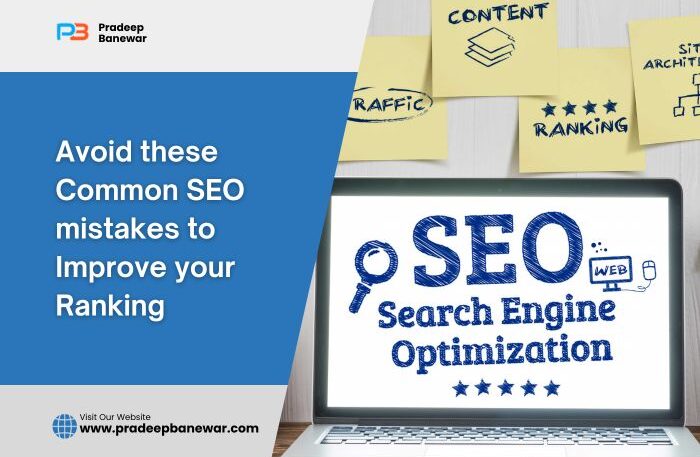For online presence in the digital world, Search Engine Optimization (SEO) knowledge is critical. It is very important to avoid common SEO mistakes as a beginner. These mistakes, which are frequently accidental, can prevent your efforts to move up search engine results pages.
This introduction lays the groundwork for identifying these threats and exposing preventative measures. The key to a good SEO strategy is identifying these frequent mistakes, whether you’re a seasoned webmaster or just starting your digital marketing journey. Let’s set out on a trip to expose these traps and clear a path towards SEO greatness.

Tips 1: Keyword Research
“Keyword Research” is the cornerstone upon which your entire approach is built in the complex world of SEO. One of the common SEO mistakes that might reduce your website’s exposure and growth potential is ignoring this important step.
Finding the accurate words and phrases that your target audience enters into search engines like Microsoft Bing, Yandex, Bidu, and Google is known as keyword research. Because they link you with users actively looking for what you have to offer, these are the keywords you want to rank for. But the process entails more than just coming up with suitable terms; it also calls for accuracy and planning.
You can find appropriate terms in your niche using keyword research tools like Google Keyword Planner, SEMrush, or Ahrefs keyword generator tool. Achieve a balance between competition and search volume. Consider long-tail keywords, which are longer, more accurate phrases that frequently have less competition, as they can be a good target for new websites to rank for than highly competitive keywords.
Prevent the common SEO mistake of over-optimizing by sparingly using keywords in your text. Instead, include them naturally in content, headlines, and meta descriptions. It improves the user experience while also assisting search engines in comprehending your content.
Keep in mind that efficient keyword research is a continuous process. As trends shift and your business grows, do not forget to update your keyword list. You can build a strong foundation for your SEO strategy and find the way to future success by mastering this first technique.
Tips 2: High-Quality Content
For SEO, high-quality content creation is not just a choice; it is also your best defense against common SEO mistakes. While technical factors and keyword optimization are critical, your SEO efforts will fail without great content.
High-quality content includes more than just words on a website; it adds value and encourages user interaction. Your content becomes a powerful tool for drawing in and keeping visitors when it speaks to their needs and interests.
One of the most common SEO mistakes is creating thin, low-value content to pack with keywords or get clicks. This strategy not only hurts your rankings but also the reputation of your brand.
Concentrate on the following areas to produce high-quality content:
- Relevance: Make sure your content speaks to the concerns and interests of your target audience. To maintain relevancy, incorporate your chosen keywords naturally throughout the content.
- Value: Address the user’s inquiry or intent by providing relevant, interesting, or helpful information. Provide thorough responses to their queries or difficulties.
- Originality: It’s essential to prevent common SEO mistakes like plagiarism and duplicate content. Being original benefits search engines and separates you as a leader in your field.
- User Experience: Content that is simple to read, well-structured, and includes images, videos, and headlines improves the user experience by promoting more visits and lowering bounce rates.
Recall that providing excellent value to your audience is essential to SEO success as using the right strategy. High-quality content protects your website against common SEO mistakes while boosting its reputation and influence in the search engine result pages.
Tips 3: Mobile Optimization
In the digital age, mobile optimization is crucial, and no longer a choice but an essential requirement. As the popularity of smartphones and tablets rises, it is essential to modern SEO that your website runs smoothly on mobile devices.
Google’s dedication to giving mobile-friendly websites priority because of the search engine’s mobile-first indexing strategy. It means that Google ranks and indexes websites primarily using their mobile versions. You are losing visibility in search results if your website isn’t mobile-friendly.
Consider the following critical factors for efficient mobile optimization:
- Responsive Design: Spend money on a web design that responds to various screen sizes. It ensures that your content displays and works properly on gadgets, including big desktop monitors and smartphones.
- Page Speed: Mobile users frequently need access to information quickly and are on the go. To optimize page speed for mobile devices, reduce the amount of code, compress pictures, and use browser caching.
- Mobile-Friendly Content: Check that text can be read without zoom-in and that buttons or links are easily clickable on touch screens. When designing content, utilize readable typefaces and consider the experience of mobile users.
- Testing: To find problems and guarantee a seamless user experience, test your website frequently on various mobile devices and browsers.
- Mobile SEO: Keep in mind mobile-specific SEO factors, such as optimizing for local search and, if appropriate, utilizing mobile app indexing.
Another SEO error that can harm your website’s performance and user experience is failing to prioritize mobile optimization. Adopting mobile-first principles can help you increase your SEO efforts and better serve the expanding mobile user base to increase your online success.
Tips 4: Optimized Titles and Meta Descriptions
The unrecognized heroes of SEO are optimized titles and meta descriptions, which are crucial for generating organic traffic and raising click-through rates (CTRs). These components are what search engine users see when they arrive at your website, making them crucial to any SEO strategy.
- Creating clickable headings: The headline of your search result listing is your title tag. It should encourage readers to click while correctly reflecting the information on your page. Include related keywords naturally, preferably close to the start of the title. To display the keyword in search results, keep it short generally around 50-60 characters.
- Powerful Meta Descriptions: Meta descriptions give a brief overview of the information on your page. Aim for 150–160 characters and to entice readers to click. Offer a brief preview of what the user might expect when they visit your website and naturally include your keywords.
- Avoid Keyword Stuffing: Stuffing keywords into titles and meta descriptions is a typical SEO error to avoid. If you do not want to be penalized by search engines like Microsoft Bing, Baidu, Yahoo, Yandex, and Google, then make sure your content does not feel unnatural while reading.
- Personalize for Each Page: To appropriately reflect the content of each page on your website, customize the titles and meta descriptions for each page separately. It improves SEO effectiveness and user experience.
- A/B Testing: Use A/B testing to improve your meta descriptions and titles. To find the language and calls to action that the target audience responds to most favorably, experiment.
In addition to increasing your website’s position in search engine result pages, enhancing titles and meta descriptions will encourage readers to click through to your content.
Tips 5: Internal Linking
Internal linking is a powerful approach that can dramatically enhance user experience and search engine rankings. It is regarded as the unrecognized hero of SEO. To implement this tactic, you must link your website pages with each other in the same domain. Here is why it’s important:
- Improving User Experience: Internal links act as a road map for users, pointing them to related content and encouraging further exploration of your website. They enhance navigation, lower bounce rates, and maintain visitor interest.
- Distributing Link Juice: Internal links circulate link juice, often referred to as link authority to your website. You pass part of that SEO value when you link from a page with high authority to one with low authority, which helps raise the connected page’s ranks.
- Creating a Content Hierarchy: By choosing which pages on your website to link, you can create a content hierarchy that denotes the most crucial pages. It aids search engines in comprehending the organization of your website and the relative significance of the various pages.
- Constructing Internal Links: Use descriptive anchor text rather than keyword anchors. It not only clarifies for consumers where the link leads, but it also informs search engines about the subject of the connected website.
- Consistent Audits: Check the internal links in your website as they are still relevant and functioning. To maintain an uninterrupted user experience, fix broken links and update out-of-date ones.
Internal linking is a component of an effective SEO strategy since it increases usability and search engine visibility. Frequently ignored advice can significantly improve the SEO performance of your website, and user experience.
Tips 6: User-Friendly URLs
User-friendly URLs are crucial for SEO and user experience. The signpost that directs visitors across your website and affects your search engine ranking is a web address.
- Clean and Descriptive URLs: A user-friendly URL is unambiguous, brief, and offers some context for the information on the page. For example, “www.yourwebsite.com/blog/seo-tips” is more interesting and instructive than “www.yourwebsite.com/page123.”
- Avoiding URL Parameters: URL parameters, symbols like ampersands and question marks, can make URLs look clumsy and unclear. Choose legible, static URLs whenever possible.
- Appropriate Redirects: Make sure to use 301 redirects if you update the URLs or structure of your website. It maintains the user experience and the old URL visitor is redirected to the new one.
User-friendly URLs improve user experience by making it simpler for visitors to comprehend the organization and content of your website. Search engines like Google prefer clean URLs. They make it simpler for them to understand the content of the page.
Tips 7: Image Optimization
The importance of image optimization in SEO is frequently understated. Beyond enhancing the beauty of your website, correctly optimized photos may enhance the user experience, website loading speed, and search engine rankings.
- The significance of visual content: Engaging visitors requires the use of visual content, which includes both photos and videos. High-quality, related images grab viewers’ attention and spread information.
- Image Compression: Images can compressed to minimize file size without sacrificing quality. Smaller picture files load more quickly, which enhances page performance. There are numerous plugins and solutions available to automate this procedure.
- Alt Text: Alt text is known as a thumbnail description of an image. It serves two purposes: it clarifies the content for those who are blind, and it gives search engines information about the image. Use alt text that is suggestive and contains relevant keywords.
- Image Sitemaps: By developing an image sitemap, you help search engines comprehend the photos on your website. Improved visibility in image search results may result from this, increasing organic traffic.
- Responsive photos: To improve the user experience for desktop and mobile users, ensure that your photos are responsive and adjust to various screen sizes and resolutions.
- Lazy Loading: Use this technique to postpone loading photos. It may speed up page loads even further.
Image optimization has a direct impact on SEO and goes beyond aesthetics. Unoptimized pictures can cause pages to load slowly, which can cause increased bounce rates and poorer rankings. These image optimization techniques can improve your website’s visual attractiveness, user experience, and SEO rankings.
Tips 8: Regular Content Updates
“Regular Content Updates” are your secret weapon to keep your website visible to search engines and effectively engage your audience in the changing world of SEO.
- The freshness factor: Fresh content is favored by search engines. They prioritize websites that update their information frequently since it conveys relevancy and dependability.
- Risks of obsolete content: If you neglect to update your content, it may contain information that will turn away visitors and spoil your credibility. Banal content is also penalized by Google.
- Algorithm Changes: Search engines like Google are constantly changing their algorithms. What was successful for SEO a year ago, is not guaranteed that it will be also successful today. Changing your content may adjust to algorithm changes and preserve or raise your ranks.
- User Engagement: Constantly updating your content keeps users interested. When returning visitors discover beneficial content on your website, they are more inclined to stick around and become devoted subscribers.
- Information Upkeep: Review and reload images, videos, and links in addition to updating text-based information. Make sure that every component on your pages is current and working.
- Monitoring and Metrics: Use analytics tools to monitor the effectiveness of your content. Using traffic, bounce rates, and user interaction, determine which pages need to be updated.
“Regular Content Updates” give your website life, keep your content current, and show your dedication to giving your readers the most recent information. This advice improves your website’s compatibility with search engine preferences while encouraging visitor loyalty and trust, which will help your SEO efforts.
Tips 9: Social Media Integration
The merging of social media with SEO is a frequently underused tactic in the constantly changing world of digital marketing. By successfully integrating social media into your SEO efforts, you may improve your online visibility and avoid common SEO faults.
- Social Signals Are Important: Search engines include social signals, like shares, comments, and likes, as parameters of the relevancy and value of the content. Search engines are more inclined to value your content the more it is shared on social media.
- Content Amplification: Social media platforms help to reach a wide targeted audience with your valuable content. Your chances of driving organic traffic to your website increase if you share your infographics, videos, and blog posts on social media.
- Community Engagement: Utilizing social media to interact with your audience builds a sense of belonging and trust. Repeat visitors to the website, and increased brand loyalty, both benefits for SEO, might arise from this.
- Quality backlinks and referral traffic: Social media is a source of backlinks and traffic from referrals. When well-known individuals or websites link to your content, it may generate inbound links and more traffic.
- Use relevant keywords in your social media posts and profiles to optimize them. It increases the exposure of your social media content in search engine results and searchability within the platform.
Your online presence may increase, and SEO mistakes are avoided by effectively including social media in your SEO plan. While maintaining an online presence, this alliance can dramatically improve the website’s SEO performance.
Tips 10: Monitor and Adapt
Success in the constantly changing world of SEO depends on always being watchful. The key to an efficient SEO approach is in tip number 10, “Monitor and Adapt,” which will help you succeed and keep you away from common SEO mistakes.
- Algorithm Changes: Search engines like Google are constantly changing their algorithms. What is effective today may not be in the future. Keep track of algorithm modifications from significant search engines like Google and adjust your strategy as necessary.
- Analytics Insights: Take advantage of analytics software to monitor your website and content. To pinpoint areas that need attention and development, analyze traffic sources, conversion rates, and user behavior.
- Competitor Analysis: Pay attention to your rivals. To achieve a competitive advantage, evaluate your competitors’ SEO techniques, pinpoint their advantages and disadvantages, and modify your strategy accordingly.
- Keyword patterns: Over time, keyword patterns can change. Keep up with the latest developments in keyword research, and adjust your content to reflect prevailing user tastes and search habits.
- Technical Audits: Conduct regular technical reviews of your website to find problems like broken links, slow loading times, and concerns with mobile friendliness. To keep SEO healthy, deal with these problems as soon as possible.
- Content Refresh: Review and update your current content regularly. In addition to avoiding the common SEO mistake of using banal, old content, this helps retain relevancy and boost ranks.
“Monitor and Adapt” is a continuous and consistent process not just a one-day, or weekly task. Success in SEO demands ongoing attention to detail, flexibility in response to market shifts, and a dedication to avoiding common SEO mistakes. You can also contact a digital marketing consultant who will help you to prepare your SEO strategy. By being proactive, you can guarantee that your website will continue to be effective in the ever-evolving digital environment.
Avoiding common SEO errors emerges as a sign of knowledge in online visibility and digital achievement. The journey of these ten suggestions has enlightened the road to efficient SEO, encouraging an enhanced user experience and better search engine rankings.
Every element, from the fundamental recommendation of keyword research to the ongoing procedure of monitoring and adaption, is essential to maintaining your website’s popularity in the digital world. When properly practiced, these insights turn unremarkable websites into succeeding online goals.
Remember that SEO is a never-ending process. You can contact a digital marketing agency for SEO services if you are an SEO beginner. They will help you to optimize your website for search engines and improve its ranking. User behavior changes, search engine algorithms change, and your competitors adjust. These ten suggestions will provide the tools to avoid stagnation and stay adaptable to change.
Finally, avoiding common SEO mistakes is a commitment to excellence. You find the route for your digital success by concentrating on keyword research, high-quality content, mobile optimization, and other fundamental concepts. When done correctly, SEO promotes brand legitimacy, user trust, and long-term growth in addition to rankings. Take these recommendations to heart, remain watchful, and watch your internet presence grow.




